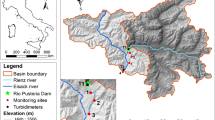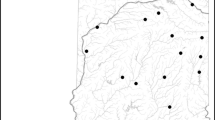Abstract
Although the utility of using either fish or benthic invertebrates as biomonitors of stream quality has been clearly shown, there is little comparative information on the usefulness of the groups in any particular situation. We compared fish to invertebrate assemblages in their ability to reflect habitat quality of sediment-impacted streams in agricultural regions of northeast Missouri, USA. Habitat quality was measured by a combination of substrate composition, riparian type, buffer strip width, and land use. Invertebrates were more sensitive to habitat differences when structural measurements, species diversity and ordination, were used. Incorporating ecological measurements, by using the Index of Biological Integrity, increased the information obtained from the fish assemblage. The differential response of the two groups was attributed to the more direct impact of sediments on invertebrate life requisites; the impact of sedimentation on fish is considered more indirect and complex, affecting feeding and reproductive mechanisms.
Similar content being viewed by others
Literature cited
Balon, E. K. 1975. Reproductive guilds of fishes: a proposal and definition.Journal of the Fisheries Research Board of Canada 32:821–864.
Brusven, M. A., and K. V. Prather. 1974. Influence of stream sediments on distribution of macrobenthos.Journal of the Entomological Society of British Columbia 71:25–32.
Chandler, J. R. 1970. A biological approach to water quality management.Water Pollution Control 4:415–422.
Chutter, F. M. 1969. The effects of silt and sand on the invertebrate fauna of streams and rivers.Hydrobiologia 34:57–76.
Cordone, A. J., and D. W. Kelley. 1961. The influences of inorganic sediment on the aquatic life of streams.California Fish and Game 47:189–228.
Culp, J. M., and R. W. Davies. 1980. Reciprocal averaging and polar ordination as techniques for analyzing lotic macroinvertebrate communities.Canadian Journal of Fisheries and Aquatic Sciences 37:1358–1364.
Cummins, K. W., and G. H. Lauff. 1969. The influence of substrate particle size on the microdistribution of stream benthos.Hydrobiologia 34:145–181.
Farnworth, E. G., M. G. Nichols, C. N. Vann, L. G. Wolfson, R. W. Bosserman, P. R. Hendrix, F. B. Golley, and J. L. Cooley. 1979. Impacts of sediment and nutrients on biota in surface waters of the United States. EPA-600/3-79-105. Environmental Research Laboratory, Athens, Georgia.
Fausch, K. D., J. R. Karr, and P. R. Yant. 1984. Regional application of an index of biotic integrity based on stream fish communities.Transactions of the American Fisheries Society 113:39–55.
Fenneman, N. M. 1983. Physiography of eastern United States. McGraw-Hill, New York.
Frost, S., M. T. L. Chiv, and M. P. Thomas. 1976. Seasonal changes of invertebrate populations in the polluted River Medlock.Environmental Pollution 11:223–242.
Gauch, H. G., Jr. 1982. Multivariate analysis in community ecology. Cambridge University Press, New York.
Gauch, H. G., Jr. and R. H. Whittaker. 1972. Comparison of ordination techniques.Ecology 53:865–875.
Gilbert, C. R. 1980. Zoogeographic factors in relation to biological monitoring of fish. Pages 309–356in C. H. Hocutt and J. R. Stauffer, Jr. (eds.), Biological monitoring of fish. Lexington Books, D. C. Heath and- Company, Lexington, Massachusetts.
Green, R. 1979. Sampling design and statistical methods for environmental biologists. John Wiley and Sons, New York.
Hellawell, J. 1977. Biological surveillance and water quality monitoring. Pages 69–88in J. S. Alabaster (ed.), Biological monitoring of inland fisheries. Applied Science, London.
Hendricks, M. L., C. H. Hocutt, and J. R. Stauffer, Jr. 1980. Monitoring of fish in lotic habitats. Pages 205–231in C. H. Hocutt and J. R. Stauffer, Jr. (eds.), Biological monitoring of fish. Lexington Books, D. C. Heath and Company, Lexington, Massachusetts.
Hill, M. O. 1972. Reciprocal averaging: an eigenvector method of ordination.Journal of Ecology 61:237–249.
Hill, M. O. 1979.Decorana: a Fortran program for detrended correspondence analysis and reciprocal averaging. Section of Ecology and Systematics, Cornell University, Ithaca, New York.
Hockensmith, R. D., and J. G. Steele. 1962. Soil erosion: the work of uncontrolled water. US Department of Agriculture, Soil Conservation Service, Agriculture Information Bulletin 260. US Government Printing Office, Washington, DC.
Hocutt, C. H. 1981. Fish as indicators of biological integrity.Fisheries (Bethesda) 6(6):28–30.
Hocutt, C. H., and J. R. Stauffer, Jr. (eds.). 1980. Biological monitoring of fish. Lexington Books, D. C. Heath and Company, Lexington, Massachusetts.
Karr, J. R. 1981. Assessment of biotic integrity using fish communities.Fisheries (Bethesda) 6(6):21–27.
Karr, J. R., and I. J. Schlosser. 1978. Water resources and the land-water interface.Science 201:229–234.
Keenleyside, M. H. A. 1979. Diversity and adaptation in fish behavior.In Zoophysiology, vol. 11. Springer-Verlag, New York.
Lamberti, G. D., and V. H. Resh. 1978. Substrate relationships, spatial distribution patterns, and sampling variability in a stream caddisfly population.Environmental Entomology 8:561–567.
Langlois, T. H. 1941. Two processes operating for the reduction in abundance or elimination of fish species from certain types of water areas.Transactions of the North American Wildlife Conference 6:189–201.
Muncy, R. J., G. J. Atchinson, R. V. Bulkley, B. W. Menzel, L. G. Perry, and R. C. Summerfelt. 1979. Effects of suspended solids and sediment on reproduction and early life of warmwater fishes: a review. EPA-600/3-79-0. Corvallis Environmental Research Laboratory, Corvallis, Oregon.
Nuttall, P. M., and E. D. Bielby. 1973. The effects of China clay on stream invertebrates.Environmental Pollution 5:77–86.
Perry, J. A., R. C. Ward, and J. C. Loftis. 1984. Survey of state water quality monitoring programs.Environmental Management 8:21–26.
Pflieger, W. L. 1975. The fishes of Missouri. Missouri Department of Conservation, Jefferson City, Missouri.
Platts, W. S., W. F. Megahan, and G. W. Minshall. 1983. Methods for evaluating stream, riparian, and biotic conditions. General Technical Report INT-138. US Department of Agriculture, Forest Service, Intermountain Forest and Range Experiment Station, Ogden, Utah.
Pollard, J. E., and W. L. Kinney. 1979. Assessment of macroinvertebrate monitoring techniques in an energy development area: a test of the efficiency of these macroinvertebrate sampling methods in the White River. EPA 600/7-79-163.
Rabeni, C. F., and G. W. Minshall. 1977. Factors affecting microdistribution of stream benthic insects.Oikos 29:33–43.
Rabeni, C. F., and K. E. Gibbs. 1980. Ordination of deep river invertebrate communities in relation to environmental variables.Hydrobiologia 74:67–76.
Rafferty, M. D., R. H. Gorlach, and D. J. Hrebec. 1970. Atlas of Missouri. Aux-Arc Research Associates, Springfield, Missouri.
Reice, S. R. 1980. The role of substrate in benthic macroinvertebrate microdistribution and litter decomposition in a woodland stream.Ecology 61:580–590.
Resh, V. H., D. M. Rosenberg, and J. W. Feminella. 1985. The processing of benthic samples: responses to one 1983 NABS questionnaire.Bulletin of the North American Benthological Society 2:5–11.
Smith, P. W. 1971. Illinois streams: a classification based on their fish and an analysis of factors responsible for disappearance of native species. Biological Notes no. 76. Illinois Natural History Survey, Urbana, Illinois.
Starrett, W. C. 1950. Food relationships of the minnows of the Des Moines River, Iowa.Ecology 31:215–233.
Strahler, A. N. 1957. Quantitative analysis of watershed geomorphology.Transactions of the American Geophysical Union 38:913–920.
Wilhm, J. L., and T. C. Dorris. 1968. Biological parameters for water quality criteria.BioScience 18:477–481.
Yount, B. 1983. Missouri farm facts. Missouri Crop and Livestock Reporting Service, Missouri Department of Agriculture. Jefferson City, Missouri.
Author information
Authors and Affiliations
Additional information
The Unit is sponsored by the US Fish and Wildlife Service, the Missouri Department of Conservation and the University of Missouri.
Rights and permissions
About this article
Cite this article
Berkman, H.E., Rabeni, C.F. & Boyle, T.P. Biomonitors of stream quality in agricultural areas: Fish versus invertebrates. Environmental Management 10, 413–419 (1986). https://doi.org/10.1007/BF01867267
Issue Date:
DOI: https://doi.org/10.1007/BF01867267




